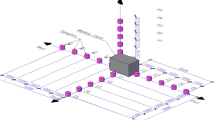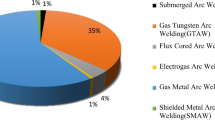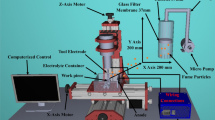Abstract
This paper aims to present the measurements and analysis results of welding fume concentration and particles character in nuclear island containment. The concentration of fume exposure is measured by using CCZG-2A portable personal fume meter and CEL-712 fume detector. In addition, the morphology, element composition, and particle size distribution of fume particles are analyzed through high-resolution transmission electron microscope (TEM) and energy-dispersive spectroscopy (EDS). The results show that (1) there are mainly three types of fume particles in the confined space of nuclear island, namely spherical metal particles with particle size of 0.3–2 μm, non-metal particles with particle size of 1 μm, and welding primary and secondary fume particles with particle size of several nanometer to microns. (2) On the one hand, welding workers’ individual fume exposure exceeds the standard rate by 75%, and the highest concentration exceeds the standard by more than 6 times. On the other hand, the possible welding exposure of non-welders is also beyond the standard rate, which exceeds the prescribed limit rate between 3 and 16 times. (3) Welding fume particles in confined space of nuclear island are located in the accumulation mode with particle size of 0.08–2.0 μm. The median diameter of the particle number is 0.3 μm, in which the particles account for 67% of the total particle number in the range of 0.15–0.6 μm, and 95% of the total particles in the range of 0.07–1.24 μm. The results of this study will provide support for computational fluid dynamics (CFD) numerical simulation of nuclear island welding fume decontamination in the next step.
Access provided by Autonomous University of Puebla. Download conference paper PDF
Similar content being viewed by others
Keywords
1 Introduction
Confined space is a general term for all places with poor ventilation, which is easy accumulation of toxic substances. The operation environment in confined space is complex and easy to lead to safety accidents. In this one, poisoning is one of the main risk factors for confined space operations.
As a connection technology, welding is widely used in commercial manufacture, mechanical maintenance, and civil installation. However, in the process of welding, a large amount of welding fumes are dispersed in the air and can be absorbed into the body through respiratory system. Previous studies have shown that chromium and nickel compounds in fume would cause damage to respiratory and increase the incidence of lung cancer [1]. In addition, the heavy metal cadmium can also lead damage to kidneys and bones [2,3,4,5]. Therefore, a series of researches have been carried out on the welding fume in the confined space of plants. The welding workshop of pollutants and fume control measures are investigated by Zhaiand Liand; they find that different welding workshops for different types of welding process, material, and work intensity may lead to different fume concentration measurement values. They also point out that it is difficult to timely eliminate pollutants only by overall ventilation; however, controlling pollutants at source is a more effective method [6, 7]. Liu takes the lead in estimating the parameters of the overall distribution of welding fume concentration in contact with employees in shipbuilding, metal manufacturing, and other workplace in Shanghai. Based on the sample data of fume sampling detection, they conducted a quantitative exposure assessment of welding fume [8]. Wang studies the diffusion and ventilation of welding fume in the large factory buildings and puts forward the control method of fume in the factory buildings combining displacement ventilation and local ventilation [9,10,11].
At present, research on welding fume control mainly focuses on workshops with ventilation and purification systems such as shipyards and automobile manufacturing. Less attention is paid to the problem of welding fume pollution in places without fume ventilation and purification design, such as those in the construction stage of the factory building. In this paper, the fume concentration and particle size distribution generated by welding in the confined space of nuclear island were measured and analyzed to provide a basis for the research on the control and purification of welding fume in the confined space of nuclear facilities.
2 Methods
The measuring sites are located at 3.4 m underground of the nuclear island containment. Individual sampling and measuring points are arranged in accordance with the standard. Four groups of individual fume sampling and measuring points are set, namely group A, B, C, and D. Fixed-point measurement of fume are shown in Fig. 1. According to the field measurement, the safety officer works in the area within 1 m from the solder joint during welding, and the maximum height of the breathing zone is 1.6 m, which constitutes the cylindrical area affected by welding fume. In order to obtain the maximum concentration of fume that people in the area may exposure, the measuring points are arranged in the downwind direction of fume fluid.
3 Results and Discussion
3.1 Analysis of Particle Morphology and Energy Spectrum of Fume
Through the analysis of TEM and EDS, it is found that the fume particles collected from the samples can be divided into three types in terms of morphology and contained elements, as shown in Figs. 2, 3, and 4, respectively. As can be seen from Fig. 2, the particles are compact spherical with diameters ranging from 0.3 to 2 μm. Studies have shown that the distribution range of primary particles of welding fume is roughly between 80 and 200 nm, and secondary particles are polymers with irregular structures formed by the primary particles. The primary particles that are coalesced often have no time to coagulate and become complete spheres. Therefore, it can be concluded that the particles in Fig. 2 are not primary particles of welding fume or secondary particles formed by primary particles. Through semi-quantitative analysis of element types, as shown in Table 1, Fe and O are the main components of this kind of particles. This kind of particles may be spherical particles formed by condensation and oxidation of metallic liquid masses spatter from welding spots in the air under the action of high-voltage arc when welding parts melt. The particles in Fig. 3 have an overall structure with particle size over 1 μm. As can be seen from the peak distribution figure of element mass, F and Ca are the main components of this type of particles, while the content of metallic elements is low. It can be seen that the generation of this type of particles does not come from welding, but may be non-metallic ore particles such as fume.
As shown in Fig. 4, the particles have irregular shapes, large scatter, and three elements (F, Ca and Fe) distribution peak quality. As shown in Tables 2 and 3, they also contain higher Mn and Ti. Combining with the feature of morphology and element, it can be concluded that this type of particles are secondary particles formed by the union of non-metallic particles.
3.2 Individual Exposure to Fume Concentration
It can be seen from Fig. 5, four groups of welding individual fume exposure concentration in three consecutive days are measured. The minimum measured value is 2.78 mg/m3, and maximum value is 30.15 mg/m3. Nine samples of fume concentration exceeded 4 mg/m3 (the workplace fume concentration limit prescribed by the standard) among twelve samples, which was 75%. And the maximum fume concentration exceeds the prescribed limit more than 6 times. Thus, welding fume individual exposure concentration is above standard when fume control measurements are not used.
3.3 Fume Concentration in Solder Joint Area
Figures 6, 7 and 8 shows the measurement results of fume concentration in the breathing area near the solder joint for 3 consecutive days. It can be seen that the average fume concentration at the measuring point on the first measurement day is 4.5 mg/m3, and the unqualified rate of fume concentration at the measuring point is 50% (Table 4). The maximum fume concentration is 13.76 mg/m3. On the second day, the average fume concentration is 19.2 mg/m3, and the fume concentration exceeds the threshold by 60.6%. Short period of high fume concentration is 70.5 mg/m3. On the third day, the average fume concentration is 21.5 mg/m3, and the fume concentration exceeds the threshold by 92.6%. The maximum concentration is 90.39 mg/m3.
The fume concentration around solder joint region is above the standard for more than half of the working time, and the exceed multiple is between 3 and 16, indicating that the personnel who do not directly carry out welding operation may also be affected by the welding fume.
3.4 Fume Particle Size Distribution
Figures 9, 10, and 11 show the particle size distribution histogram. It can be seen from the figures that 0–0.5 μm is the main particle size distribution range. The particle size distribution characteristics of fume particles can be described by the particle size distribution function. According to the measured number variation trend of particles in each particle size interval, logarithmic normal distribution is used [12].
where \(d_{R}\) is the geometric average diameter of particles, n is the number of particles, d is the median diameter, di is the median value of each particle size distribution interval, \(\sigma_{R}\) is the geometric standard deviation, and f(d) is the particle size distribution function.
By substituting the data into Eqs. (1)–(4), the overall size distribution function of fume particles within three days can be obtained, and the frequency density distribution function of particle size can be obtained, as shown in Fig. 12. The median diameter of fume particles is 0.3 μm, the number of particles in the range of 0.15–0.62 μm accounted for 67% of the total number, and 95% of the total number of particles range from 0.07 to 1.24 μm.
Welding fume particles usually show three kinds of modes, namely Aitken mode, accumulation mode, and coarse mode [13]. The above analysis shows that under 0.5 μm in diameter particles accounted for more than 50% of the total number. Accumulation mode particles (0.08–2.0 μm) are the main components of fume.
4 Conclusions
-
(1)
The particles in the containment mainly can be divided into three types. The first is spherical particle which is formed by metal spattering condensing and oxidizing. The second is non-metallic particle emitted from construction materials. The last is irregular secondary particle formed by collision and cohesion between welding steam particle.
-
(2)
Within the confined space of the nuclear island, the unqualified rate of individual welding fume exposure is above 75%, and the maximum concentration exceeds the standard more than 6 times. Fume concentration exceeds 3–16 times during half of the working time. In addition to welding operators, indirect welding operators will also be threatened by welding fume. Therefore, in the construction of confined space on the nuclear island, the hazard of welding fume to site workers should be considered, and effective protective measures should be taken for those who may be endangered by welding fume.
-
(3)
Welding fume in the containment is formed by accumulation mode particles. Particles’ median diameter is 0.3 μm. Particles’ diameter ranging from 0.15 microns to 0.62 microns accounts for 67% of the total particles and 95% of total particles’ diameter distributes within the scope of 0.07 microns to 1.24 microns. Therefore, submicron particles should be paid more attention when take measures to control and purify welding fumes in the nuclear island containment.
References
Lehnert, M., Hoffmeyer, F., Gawrych, K.: Effects of exposure to welding fume on lung function: results from the German WELDOX Study. Environment Exposure to Pollutants. Springer (2015)
Taylor, A.J.: Cadmium fume inhalation and emphysema. Lancet 1(8587), 663–670 (1988)
Huang, Y., Wang, Y., Shi, Y.: Analysis of welding fume monitoring results in shipyards. J. Environ. Occup. Med. 28(3), 159–160 (2011)
Zhang, S., Wang, R., Feng, B.: Test and analysis of welding fume and manganese dioxide level in a large shipyard. Chin. Occup. Med. 2017(6), 780–783 (2017)
Cheng, H., Huang, D., Zhang, Q.: Survey and assessment on occupational exposure to welding fume in a machinery manufacturing plant. Chin. J. Ind. Med. 2017(2), 147–148 (2017)
Zhai, J., Jiang, W.: Treatment measures on removing weld fume in the workplace for welding containers. Chin. J. Public Health Eng. 6(1), 13–15 (2007)
Gu, L.: Monitoring Analysis and Control Strategy to Harmful Substances in the Air of Welding Workplace in Dalian. Dalian Maritime University (2015)
Liu, M., Yang, F., Ding, W.: Quantitative exposure assessment of welding fumes in workplaces of Shanghai in 2012. J. Environ. Occup. Med. 31(2), 81–87 (2014)
Wang, H., Huang, C., Liu, D.: Fume transports in a high rise industry welding hall with displacement ventilation system and individual ventilation units. Build. Environ. 52(6), 119–128 (2012)
Wang, F., Liu, Z., Treeck, V.C.: Double diffusive convection in a high-rise welding hall with stratified ventilation system. J. Centr. South Univ. 47(4), 1447–1458 (2016)
Wang, F., Liu, Z., Treeck, V.C.: Heat and hazardous contaminant transports in ventilated high-rise industry halls. J. Centr. South Univ. 22(6), 2106–2118 (2015)
Lu, Z.: An Introduction to Aerosol Science. Atomic Energy Press, Beijing (2000)
Whitby, K.T.: The physical characteristics of sulfur aerosols aerosols. Atmos. Environ. 12(1), 135–159 (1978)
Acknowledgements
The project is supported by Hunan Provincial Innovation Foundation for Postgraduate (Number CX2017B504) and Scientific research project of China Nuclear Industry 23 Construction Co., Ltd. (CNEC-CNI123-KY-2017-06).
Author information
Authors and Affiliations
Corresponding author
Editor information
Editors and Affiliations
Rights and permissions
Copyright information
© 2020 Springer Nature Singapore Pte Ltd.
About this paper
Cite this paper
Li, C., Wang, H., Li, W., Ye, Y., Wang, M. (2020). Measurement and Analysis of the Concentration and Size Distribution of Welding Fume in a Confined Space. In: Wang, Z., Zhu, Y., Wang, F., Wang, P., Shen, C., Liu, J. (eds) Proceedings of the 11th International Symposium on Heating, Ventilation and Air Conditioning (ISHVAC 2019). ISHVAC 2019. Environmental Science and Engineering(). Springer, Singapore. https://doi.org/10.1007/978-981-13-9520-8_50
Download citation
DOI: https://doi.org/10.1007/978-981-13-9520-8_50
Published:
Publisher Name: Springer, Singapore
Print ISBN: 978-981-13-9519-2
Online ISBN: 978-981-13-9520-8
eBook Packages: Earth and Environmental ScienceEarth and Environmental Science (R0)
















